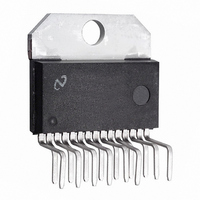LM4702BTA/NOPB National Semiconductor, LM4702BTA/NOPB Datasheet - Page 12

LM4702BTA/NOPB
Manufacturer Part Number
LM4702BTA/NOPB
Description
IC AMP AUDIO PWR 300W TO220-15
Manufacturer
National Semiconductor
Type
Class ABr
Datasheet
1.LM4702CTANOPB.pdf
(16 pages)
Specifications of LM4702BTA/NOPB
Output Type
2-Channel (Stereo)
Max Output Power X Channels @ Load
300W x 2 @ 8 Ohm
Voltage - Supply
±20 V ~ 100 V
Features
Mute, Thermal Protection
Mounting Type
Through Hole
Package / Case
TO-220-15 (Bent and Staggered Leads)
Amplifier Class
AB
No. Of Channels
2
Output Power
300W
Supply Voltage Range
± 20V To ± 100V
Load Impedance
8ohm
Operating Temperature Range
-20°C To +75°C
Amplifier Case Style
TO-220
Rohs Compliant
Yes
For Use With
LM4702TABD - BOARD EVALUATION LM4702TA
Lead Free Status / RoHS Status
Lead free / RoHS Compliant
Other names
LM4702BTA
Available stocks
Company
Part Number
Manufacturer
Quantity
Price
Company:
Part Number:
LM4702BTA/NOPB
Manufacturer:
AIMTEC
Quantity:
1 200
www.national.com
Application Information
bias point on the amplifier’s input terminal. The resulting
-3dB frequency response due to the combination of C
R
With large values of R
outputs when the inputs are left floating. Decreasing the
value of R
oscillations. If the value of R
C
frequency response.
AVOIDING THERMAL RUNAWAY WHEN USING
BIPOLAR OUTPUT STAGES
When using a bipolar output stage with the LM4702 (as in
Figure 1), the designer must beware of thermal runaway.
Thermal runaway is a result of the temperature dependence
of Vbe (an inherent property of the transistor). As tempera-
ture increases, Vbe decreases. In practice, current flowing
through a bipolar transistor heats up the transistor, which
lowers the Vbe. This in turn increases the current again, and
the cycle repeats. If the system is not designed properly, this
positive feedback mechanism can destroy the bipolar tran-
sistors used in the output stage.
IN
IN
can be found from Equation (5) shown below:
will need to increase in order to maintain the same -3dB
IN
or not letting the inputs float will remove the
f
IN
= 1 / (2πR
IN
oscillations may be observed on the
IN
is decreased then the value of
IN
C
IN
) (Hz)
(Continued)
IN
and
(5)
12
One of the recommended methods of preventing thermal
runaway is to use a heat sink on the bipolar output transis-
tors. This will keep the temperature of the transistors lower.
A second recommended method is to use emitter degenera-
tion resistors (see Re1, Re2, Re3, Re4 in Figure 1). As
current increases, the voltage across the emitter degenera-
tion resistor also increases, which decreases the voltage
across the base and emitter. This mechanism helps to limit
the current and counteracts thermal runaway.
A third recommended method is to use a “Vbe multiplier” to
bias the bipolar output stage (see Figure 1). The Vbe multi-
plier consists of a bipolar transistor (Qmult, see Figure 1)
and two resistors, one from the base to the collector (Rb2,
Rb4, see Figure 1) and one from the base to the emitter
(Rb1, Rb3, see Figure 1). The voltage from the collector to
the emitter (also the bias voltage of the output stage) is
Vbias = Vbe(1+Rb2/Rb1), which is why this circuit is called
the Vbe multiplier. When Vbe multiplier transistor (Qmult,
see Figure 1) is mounted to the same heat sink as the bipolar
output transistors, its temperature will track that of the output
transistors. Its Vbe is dependent upon temperature as well,
and so it will draw more current as the output transistors heat
it up. This will limit the base current into the output transis-
tors, which counteracts thermal runaway.








